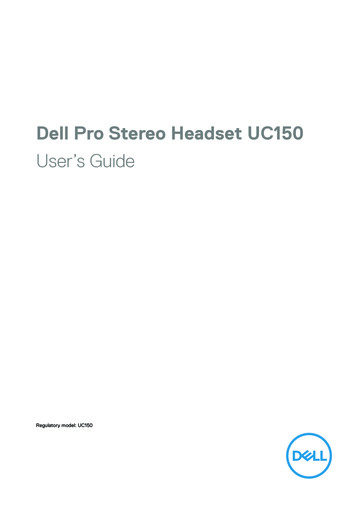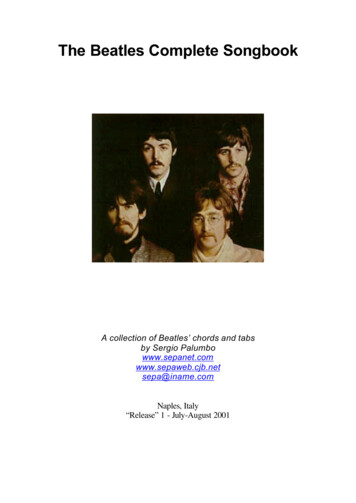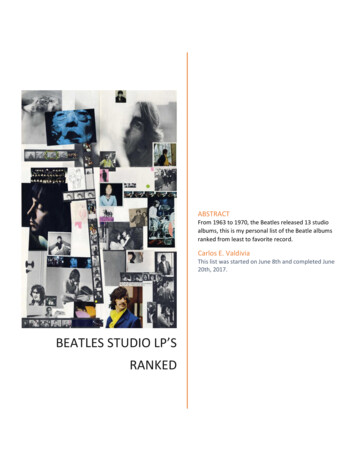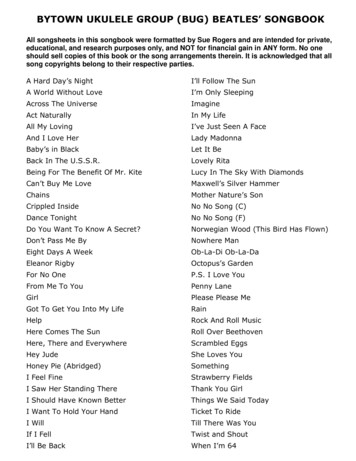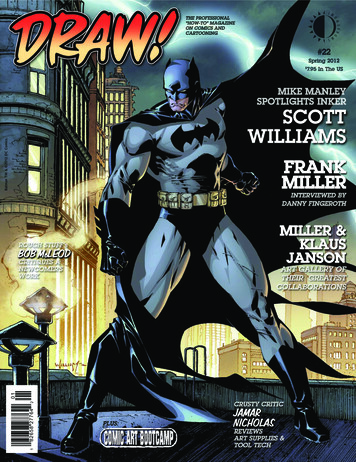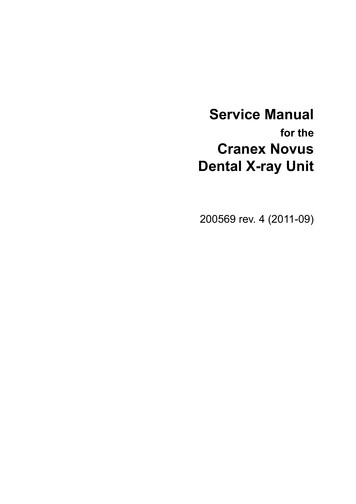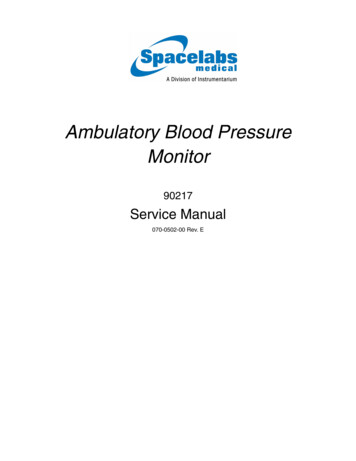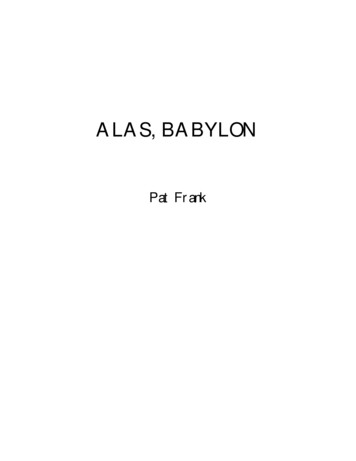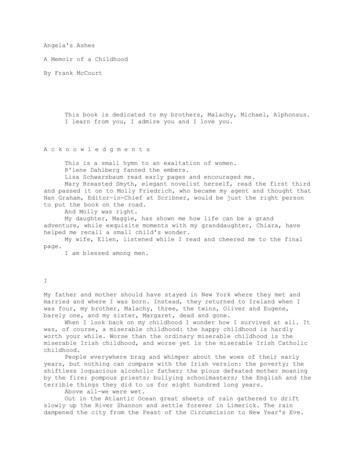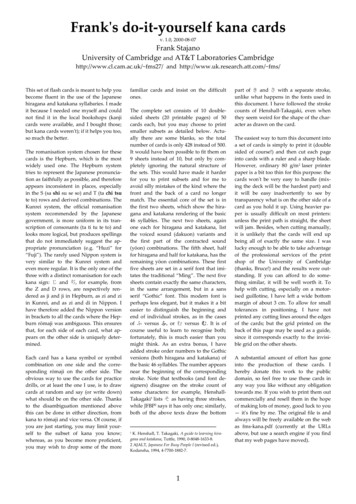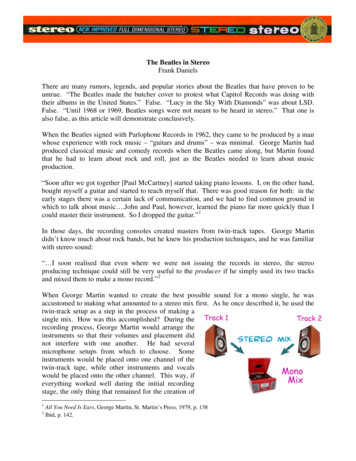
Transcription
The Beatles in StereoFrank DanielsThere are many rumors, legends, and popular stories about the Beatles that have proven to beuntrue. “The Beatles made the butcher cover to protest what Capitol Records was doing withtheir albums in the United States.” False. “Lucy in the Sky With Diamonds” was about LSD.False. “Until 1968 or 1969, Beatles songs were not meant to be heard in stereo.” That one isalso false, as this article will demonstrate conclusively.When the Beatles signed with Parlophone Records in 1962, they came to be produced by a manwhose experience with rock music – “guitars and drums” – was minimal. George Martin hadproduced classical music and comedy records when the Beatles came along, but Martin foundthat he had to learn about rock and roll, just as the Beatles needed to learn about musicproduction.“Soon after we got together [Paul McCartney] started taking piano lessons. I, on the other hand,bought myself a guitar and started to teach myself that. There was good reason for both: in theearly stages there was a certain lack of communication, and we had to find common ground inwhich to talk about music .John and Paul, however, learned the piano far more quickly than Icould master their instrument. So I dropped the guitar.” 1In those days, the recording consoles created masters from twin-track tapes. George Martindidn’t know much about rock bands, but he knew his production techniques, and he was familiarwith stereo sound:“ I soon realised that even where we were not issuing the records in stereo, the stereoproducing technique could still be very useful to the producer if he simply used its two tracksand mixed them to make a mono record.” 2When George Martin wanted to create the best possible sound for a mono single, he wasaccustomed to making what amounted to a stereo mix first. As he once described it, he used thetwin-track setup as a step in the process of making asingle mix. How was this accomplished? During therecording process, George Martin would arrange theinstruments so that their volumes and placement didnot interfere with one another. He had severalmicrophone setups from which to choose. Someinstruments would be placed onto one channel of thetwin-track tape, while other instruments and vocalswould be placed onto the other channel. This way, ifeverything worked well during the initial recordingstage, the only thing that remained for the creation of12All You Need Is Ears, George Martin, St. Martin’s Press, 1979, p. 138Ibid, p. 142.
a proper mono mix was some balancing and EQ’ing.All Parlophone singles were released in mono only back then, so they didn’t need to be releasedin stereo. Album tracks, however, were normally released in both mono and stereo. Ever sincestereo was introduced in 1958, George Martin was mixing albums for stereo. In All You Need isEars, he described the differences between mixing a comedy album for stereo and mixing aclassical album for stereo. Since the stereo mix was basically complete already, little needed tobe done at that point except to transfer the master tape onto a mix tape. Since mixing for twintrack had been done during the recording stage, the final stereo mix was easy to create, takingless time than the mono mix to make.No, these mixes did not merely consist of “instruments on one side and vocals on the other.”Instruments would be included with the vocal track, but not in such a way that they wouldinterfere with the vocals. “I Saw Her Standing There,” for example, features instrumentationalong with the vocal track. In fact, quite a few of the songs from the Please Please Me album arecarefully arranged so that the placement of the instruments and vocals on the twin track tape (i.e.,the stereo mix) allows them to complement one another. Listen to “Boys,” which places thedrums and vocals together, and the remarkable spread on “There’s a Place.”Although twin-track tapes were used into late 1963, thepresence of the Beatles in the studio changed the recordingprocess somewhat. In several ways, they challenged theestablished procedures. A wonderful example exists withthe recording of “Love Me Do.” The song was written byboth John and Paul, and both of them sang the song, butLennon always sang the portions of the song where therewere solo vocals. In the studio, “the late addition ofharmonica to Love Me Do caused a problem not foreseenby the Beatles in private rehearsal: who would completethe vocal line ‘love me do’ now that John had aninstrument in his mouth?” 3 George Martin instructed Paulto sing the lead vocals at those times – freeing up John toplay.Paul has described how nervous he was about taking the lead vocal in a point where he was notaccustomed to doing so. However humorous the story was, it proved to be entirely unnecessaryjust a few months later. Had “Love Me Do” been recorded later in the year, John could havesung lead. For by then, George Martin had begun introducing a second tape into the mix – an“edit tape” of short overdubs.3This event is described in the liner notes to Anthology 1.
“Please, Please Me” was recorded on three occasions:in a slow, “Roy Orbison-style” on June 4, 1962; withAndy White on drums, and with guitar fills, onSeptember 11; and the final version on November 26,1962. This last effort featured harmonica fills in theplace of the guitar riffs that had marked the Whitebacked version. Rather than pull John away from hislead vocal, George Martin decided to create a secondtape of edit pieces and to perform a tape-to-tapeoverdub after the tracks were complete.4 For a timebeing, this became the usual method of escaping theneed for a third track: segments of “edit pieces.”Unfortunately, Parlophone’s practice of wiping thesession tapes once the mono (and/or stereo) mix tape(s) had been created came back to hauntthem when the stereo album was compiled. Apparently, the November 26, 1962, session washoused on two tapes. After the mono mixes of “Please, Please Me” and “Ask Me Why” weremade on November 30, the tapes were slated for destruction. Had they anticipated the release ofan album, the final twin-track (stereo) mix would exist. Instead, the second session tape,containing the last few of the eighteen takes of “Please, Please Me,” and the six takes of “AskMe Why” survived the purge – perhaps by accident, but the whole session was not extant whenthe time came to prepare the stereo album. Therefore, an edit of three of those later takes wasprepared for release on the stereo LP on February 25, 1963 – the day that both the mono andstereo masters for the LP were made.Oddly, George Martin’s faulty memory of those earlyyears has contributed to the general feeling of distastetoward the twin-track stereo mixes that arose during the1970’s and to an extent prevails today among Beatlesfans.Although he supervised the stereo mixespersonally, he went on to write in 1979 that the earlysongs had never been released in stereo. Regarding theplanned 1976 release of the Rock and Roll Musicalbum, prepared by Capitol Records, Martin wrote,“They had put the tapes on a transfer machine and weregoing to issue them just as they were – but in stereo!The effect was disastrous.” He went on to describehow he altered the mixes that Capitol had receivedfrom Parlophone, moving tracks toward the center andadding compression and echo. After this, he wrote,“they really sounded quite tolerable.” 545The Beatles Complete Recording Sessions, Mark Lewisohn, Harmony Books, 1988, p. 23 (26 November).Op. cit. Martin, pp. 146-7.
George Martin actually forgot that he personally supervised stereo mixes of nearly every earlysong, and he was clearly unaware of the fact that not only had the songs from Please, Please Mebeen available in stereo since April of 1963, but also that the album had been available solely instereo for the past six to seven years at the time when the Rock and Roll Music album was beingcompiled. Martin’s later statements that he had never intended for the twin-track recordings tobe released in stereo led not only to a general detest of the early stereo recordings but also to the1987 decision to release the first four albums in mono only on compact disc.This happened because EMI was planning to release all of the CD’s in their original stereomixes. They contacted him in December, 1986, and he was struck at how “dreadful” they were.He got the company to agree to put the first four discs out in mono, and to let him remix the nexttwo albums. When asked about the original stereo mixes, the producer went so far as to denythat they ever existed: “I can't believe that. We issued ‘Please Please Me’ in February 1963, andcertainly no stereo mixes were made. Not by me. Not by anybody I know .I was not aware of astereo album being produced. I thought it had beendone after I left in 1965. Certainly I wasn't aware ofit at the time. Now, that may seem extraordinary toyou, but in 1963 I don't even think I had time tohave breakfast. Certainly I didn't do the stereomixes, and neither did the Beatles. Some geezer atEMI probably looked at this and said, for theminority of stereo people around, we'd better putout a stereo record.” 6Of course, people know now that the stereo albumhad been available since the “gold label” days in1963, and that it is available in many labelvariations since then. The fact is that people werebuying stereo albums in England in 1963, and eventhough mono albums outnumbered stereo ones by atleast a ten-to-one margin, nevertheless Parlophoneand George Martin made sure its audiophiles had the opportunity to purchase stereo albums –including every one released by the Beatles.The pattern of using a reel of edit pieces when overdubs were needed continued with the group’snext single. “From Me to You” and “Thank You Girl” were each recorded on March 5, 1963.Both songs featured a twin-track backing and edit pieces. The mono and stereo mixes of “ThankYou Girl” were made immediately after the last overdub session on March 13th. “From Me toYou” was mixed for mono and stereo the following day. An interesting but minor shift inphilosophy occurred between those two days, and in both cases the presence of all the edit piecesappears to have been the cause of confusion.When “Thank You Girl” was mixed for mono, some of the edit pieces were accidentally omitted,and when the song was mixed for stereo, the harmonica was mixed into the vocal track. George6“Why release the first four albums on CD in mono? Well, why not .,” Interview with Allan Kozinn, New YorkTimes, March 8, 1987.
Martin seemed particularly fond of the harmonica sound, and the possibility of its interferingwith the vocals must have occurred to him. Therefore, on the following day some harmonicaoverdubs for the stereo mix of “From Me To You” were added to both tracks. This created theappealing effect of having the harmonica in the center of the recording. Since George Martin,who supervised the mixing, later went on to write about how one could use two tracks to create afull spectrum of stereo, and since Martin had done this before with comedy and classical albums,the thought to make use of the stereo spread must have sprung to mind that day. This was alsothe first time that single tracks were mixed for stereo right away; that practice would prove to besporadic, since the production team normally only made mixes for anticipated releases.The problem with creating edit pieces was a simple one: the two tapes had to be manuallysynchronized. In 1962 and 1963, this meant that only short pieces could be used for editing,because the tapes would go out-of-synch after half a minute or so. That was not a problem forthe short overdubs on “From Me to You” and “Thank YouGirl,” but it soon proved to be a nightmare twice. As theBeatles returned to the studio on July 1st, they could not haverealized that such a fine song would necessitate a complextwin-track recording.“I’ll Get You,” which featured a harmonica overdub that ranthroughout the song, was difficult enough, but the realproblems occurred when mixing “She Loves You.” Accordingto Lewisohn, it took three reels of tape to contain therecordings of the two songs. This may mean that several dozenproper takes and edit pieces were involved.Mono mixes for just those two songs took three hours on July 4th; the entire Please Please MeLP was mixed for both mono and stereo in that span of time. Since so much guitar overdubbingneeded to be done, after editing together the “best” takes, the production team apparently brokethe song up into a number of short bits. The edit pieces were then synchronized with thosepieces of tape, and the tapes were spliced back together to make the final mono mix. On severalreleases of the song, you can hear seven edits. These occur before each verse, before eachchorus (except the first), after “because she loves you” during the last verse, and before and after“Pride can hurt you too/Apologize to her.” The edits in mid-verse are most likely edits ofdifferent takes, because the ambiance of the song changes slightly for those lines. This sameprocess was probably carried out on “I’ll Get You” as well, but the edits in that song are notobvious. Needless to say, the number of edits and sheer length of time required for such anarduous task made a stereo mix ridiculously impossible with 1963 technology, and no stereomixes were attempted.As if that wasn’t enough, the group’s next album tested the limits of twin-track recording. Tapeshad to be “bounced down” so that new material could be added on top of the existing recording.If the overdubs were placed on one side of the twin-track tape, they would appear alone in thefinal stereo mix. This was unacceptable, of course, and attention had to be paid to layering thetracks properly during the recording process. The group’s grasp of recording was evolving, andso was George Martin’s. Double-tracked vocals appear on several songs (“It Won’t Be Long,”
“Don’t Bother Me,” “Please Mister Postman,” “Roll Over Beethoven,” “Not a Se
The Beatles in Stereo . Frank Daniels . There are many rumors, legends, and popular stories about the Beatles that have proven to be untrue. “The Beatles made the butcher cover to protest what Capitol Records was doing with their albums in the United States.” False. “Lucy in the Sky With Diamonds” was about LSD. False. “Until 1968 or 1969, Beatles songs were not meant to be heard in .
